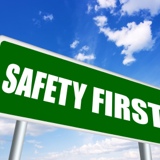Title Page
-
Conducted on
-
Prepared by
-
Location
General Requirements
-
Front and rear exit doors must have a deadbolt, seal, lock and work properly.
-
No dual-keyed double cylinder dead bolts on exit doors.
-
Good air tight doors and windows.
-
Windows designed to open must have a screen installed.
-
Windows designed to open must operate properly.
-
Windows designed to open must not be painted or nailed shut.
-
All windows must have permanently attached working locks.
-
Windowpanes must not be cracked or broken.
-
All switches, receptacles and light fixtures must be working.
-
All switches and outlets must have secured covers with no cracks.
-
All three (3) prong electrical outlets must be grounded as required by code.
-
All bathrooms must have an outlet per City Code.
-
Light fixtures must have globe covers if so designed.
-
No cable lines, extension cords or gas lines that can be a tripping hazard.
-
No exposed or frayed electrical wiring.
-
No plumbing leaks.
-
All staircases leading to living/sleeping areas must meet code requirements.
-
All walls and ceilings must be clean with no holes or large cracks.
-
No loose, peeling, chipped, or cracked paint on interior or exterior surfaces.
-
No evidence of roaches, mice, etc.
-
Carpet and floors must be clean.
-
All floors must be in a finished state.
-
Out buildings and garages must be in good shape and repair.
-
Carpet seams and edges must be in good shape and secured.
-
Bathrooms must have a window that opens or a powered vent fan.
Kitchen
-
Appliances must be in place, clean and working properly at the time of inspection.
-
Gas service line for range must have shutoff valve.
-
Disposal wiring must be secured with proper connection.
Bedrooms
-
Must have least one window and must open for egress and ventilation.
-
Security bars must be removed unless equipped with factory installed panic release hardware.
-
Windows designed to open must operate properly.
-
Bedrooms must have a minimum floor area of 8’0” by 10’0” (80 s.f.).
-
Ceiling height throughout the entire area must be at least 7’1”.
-
Bedrooms must have a built-in closet.
-
Cannot have gas hot water tanks located in bedroom areas. Call for exceptions or options.
Heating & Cooling Systems
-
All gas heating sources must be vented and working safely.
-
All units must contain a thermostatically controlled primary heat source.
-
All heating systems must be able to provide adequate heat either directly or indirectly to each room. If present, the air conditioning system must provide adequate cooling to each room. (Note; window unit A/C’s are not considered air conditioning under HQS, but if supplied by landlord must be maintained by landlord).
-
The heating and/or A/C system must be in safe and proper operating condition.
-
Gas furnace closets must have upper cumulative and lower combustion air vents.
-
Vent tubes must be a minimum of 5” diameter if only one appliance is in the closet. If closet contains both a gas furnace and a gas hot water tank, the tubes must be a minimum of 8” diameter.
-
Vents tubes must vent into the attic or to the outside. Vents in doors are unacceptable if the closet is located in a living area.
-
Non-operational floor furnaces must be removed and the opening sealed.
-
Operational floor furnaces require a certificate of proper operation and code compliance by a licensed contractor.
-
Gas space heaters (vented or un-vented) are not allowed.
-
Heat/air combination window units are not considered a primary heat source.
-
All newly installed heating systems must have a passed city inspection.
Hot Water Tanks
-
Gas hot water tank closets must have upper cumulative and lower combustion air vents. On Initial inspections gas tanks in garages must be raised 18” if required by code.
-
Vent tubes must be a minimum of 5” diameter if only one appliance is in the closet. If closet contains both a gas furnace and a gas hot water tank, the tubes must be a minimum of 8” diameter.
-
Vents tubes must vent into the attic or to the outside. Vents in doors are unacceptable if the closet is located in a living area.
-
Gas hot water tanks are not allowed in bedrooms or bathrooms. Call for options or exceptions.
-
Temperature and pressure (T&P) relief valve on hot water tanks must be present and probe must extend 4” in tank.
-
The drain line on the T&P valve must be constructed of ¾” ridged metal or CPVC and run within 6” of floor.
-
All newly installed gas hot water tanks must have a passed city inspection.
Miscellaneous
-
On each level of the dwelling unit including basements, but excluding spaces and unfinished attics, at least one battery-operated or hard-wired smoke detector in proper operating condition must be present.
-
The smoke detectors must be installed near sleeping areas.
-
Smoke detectors installed on walls must be at least 4” from the ceiling and no more that 12” from the ceiling away from return air vents and bathroom doors.
-
Smoke detectors installed on the ceiling must be at least 18” from any corners.
-
Smoke detectors must be installed in accordance with and meet the requirements of the National Fire Protection Standards (NFPA) 74 or its successor standards.
-
All owner-supplied amenities (dishwashers, disposals, ceiling fans, overhead door openers, attic fans, central air conditioning, etc.) in place at the time of the initial inspection must be in proper working order and maintained by the owner. If they become inoperable they must be repaired or replaced. They cannot be removed.
-
Detached garages, storage buildings and basements located on the property cannot be used by owners for storage. (Applies to single-family and duplex properties only).
-
Properties without separately metered utilities (water, gas or electric) must be leased as all-bills-paid for the specific utility or utilities that are not separately metered.
-
Handrails are required when four or more steps (risers) are present. Interior and exterior.
-
Protective railings are required when porches, balconies, steps and stoops are 30” or more above ground level.
-
Manufactured homes must have proper tie-down devices and must be visual to the inspector.
-
Empty slots in the breaker box must have covers.
-
If a property was constructed prior to 1978, it may contain Lead-Based Paint. Contact the Inspection Department to see if certain conditions and requirements may apply.
-
All utilities must be on during the inspection.
-
All fences and gates must be in good repair.
-
Swimming pools and hot tubs must meet code standards.
-
All properties and repairs must meet The 2003 International Property Maintenance Code as adopted by the City of Tulsa, 2006 International Property Maintenance Code as adopted by the State of Oklahoma and any building, plumbing, electrical, mechanical or national fire codes that may be applicable.
Sign Off
-
Name and Signature













